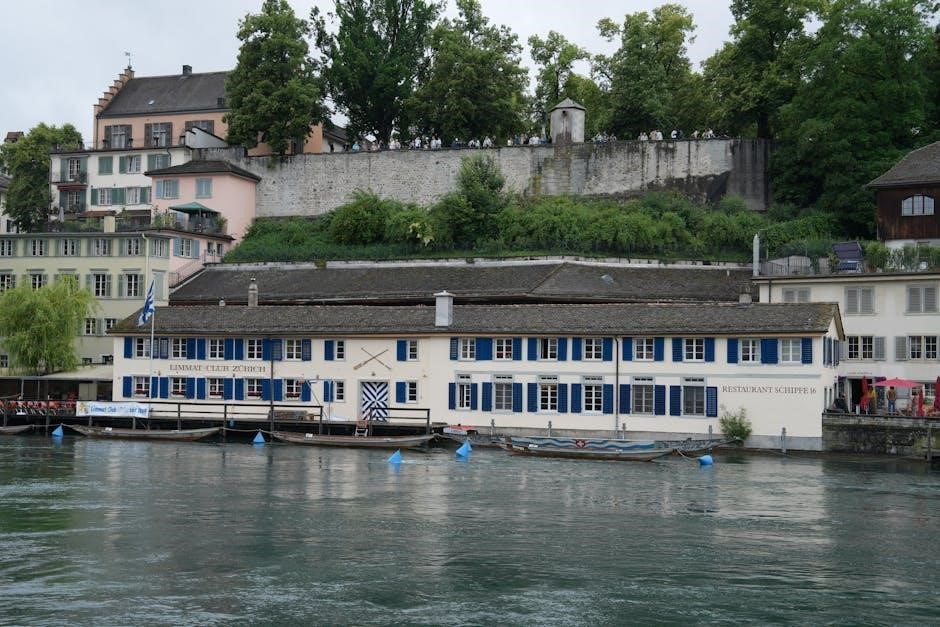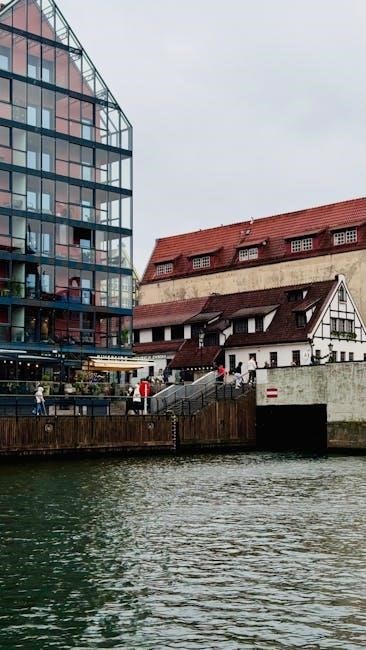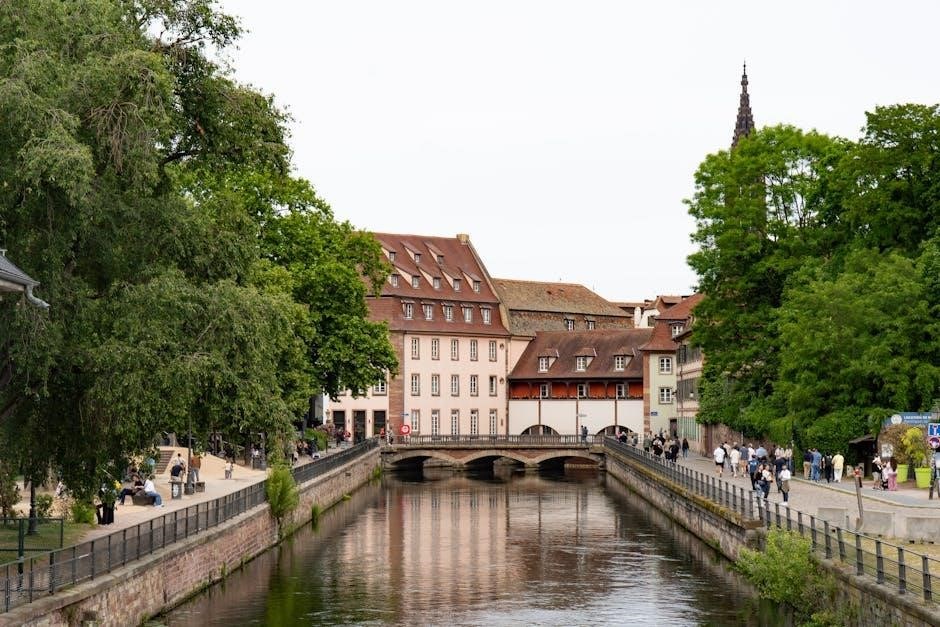
between riverside and crazy pdf
Between Riverside and Crazy, a Pulitzer Prize-winning play by Stephen Adly Guirgis, is a dark comedy that masterfully blends humor and gritty realism. The story follows Walter “Pops” Washington, a retired cop, and his son Junior as they navigate personal struggles and external pressures in a pre-war apartment on Riverside Drive. The play’s PDF version has gained popularity for its accessibility, offering readers a gripping portrait of urban life and redemption. Available in digital formats, it continues to captivate audiences with its emotional depth and cultural relevance.
Background and Significance of the Play
Between Riverside and Crazy is a Pulitzer Prize-winning play that explores themes of family, redemption, and urban struggle. Premiering at the Atlantic Theater Company in 2014, it gained acclaim for its dark comedy and gritty realism. The play’s significance lies in its ability to weave humor with heartache, offering a raw portrayal of life in New York City. Its accessible PDF format has made it widely popular, allowing readers to engage with its powerful narrative and complex characters, solidifying its place in contemporary drama;
Overview of the Plot and Themes
Between Riverside and Crazy centers on Walter “Pops” Washington, a retired NYPD officer, and his son Junior, navigating life in a decaying Riverside Drive apartment. The play intertwines dark humor with themes of family dysfunction, redemption, and urban decay. Pops battles the NYPD over his home, while Junior faces parole challenges. The story delves into struggles with authority, personal demons, and the quest for hope amidst chaos. Its themes resonate deeply, offering a poignant look at resilience and the human condition in a city teetering on the edge of collapse.

The Playwright: Stephen Adly Guirgis
Stephen Adly Guirgis is a Pulitzer Prize-winning playwright known for his gritty, humorous portrayals of urban life. His work often explores redemption and societal struggles.
Brief Biography of Stephen Adly Guirgis
Stephen Adly Guirgis is a renowned American playwright, screenwriter, and actor, born in 1965 in New York City. Known for his gritty, realistic portrayals of urban life, Guirgis’s work often explores themes of redemption, family, and social struggle. His plays, such as Between Riverside and Crazy and Our Lady of 121st Street, have garnered critical acclaim and numerous awards, including the 2015 Pulitzer Prize for Drama. Guirgis’s unique voice captures the raw essence of human resilience and the complexities of urban existence.
His Style and Contributions to Drama
Stephen Adly Guirgis’s writing style is a unique blend of dark comedy, gritty realism, and emotional depth, capturing the raw essence of urban life. His plays often feature flawed, relatable characters navigating redemption and struggle. Guirgis’s contributions to drama include a fresh voice that challenges societal norms and explores themes of family, race, and redemption. His work has influenced contemporary theater, earning him widespread acclaim and solidifying his place as a leading figure in modern American drama.
Plot Summary of “Between Riverside and Crazy”
Between Riverside and Crazy follows Walter “Pops” Washington, a retired cop, and his son Junior, navigating personal and external conflicts in a decaying pre-war apartment. The story explores themes of control, redemption, and urban decay, blending humor and heartache as the characters face struggles with the NYPD and their own demons.
Key Characters: Walter “Pops” Washington and Junior
Walter “Pops” Washington, a retired cop and widower, is the play’s central figure, struggling to maintain control over his life and pre-war apartment. His son, Junior, recently paroled, grapples with addiction and identity, seeking redemption. Their complex relationship, marked by tension and loyalty, drives the narrative, exploring themes of family, redemption, and urban decay. Pops’ stubbornness contrasts with Junior’s vulnerability, creating a dynamic that underscores the play’s emotional depth and gritty realism.
Setting: The Pre-War Apartment on Riverside Drive
The play unfolds in Walter “Pops” Washington’s grand but decaying pre-war apartment on Riverside Drive. Once a symbol of pride and comfort, the apartment now reflects Pops’ declining fortunes and emotional state. Its chandeliers and river view contrast with the wear and tear, symbolizing the characters’ struggles and the city’s encroaching gentrification. This setting serves as both a refuge and a prison, central to the plot’s exploration of urban decay and the fight to preserve a fading legacy.
Conflict: Struggles with the NYPD and Personal Demons
At the heart of the play lies Walter “Pops” Washington’s battle with the NYPD, who demand he vacate his cherished pre-war apartment. This external conflict mirrors his internal struggles, as he grapples with the loss of his wife and a lifetime of regrets. Meanwhile, Junior’s parole and identity crises add layers of tension, as both men confront their personal demons. The play masterfully intertwines these conflicts, exploring themes of control, redemption, and the resilience needed to face a world determined to unravel their lives.

Themes and Genre
Between Riverside and Crazy masterfully combines dark comedy with gritty realism, exploring themes of family, redemption, and urban life. Its genre blends humor with emotional depth.
Dark Comedy and Gritty Realism
Between Riverside and Crazy seamlessly merges dark comedy with gritty realism, creating a vivid portrayal of urban life. The play’s humor, often sharp and irreverent, contrasts with its unflinching exploration of societal struggles, such as racism and economic hardship. Guirgis’s masterful dialogue captures the rawness of his characters’ experiences while infusing moments of levity. This balance of tones not only reflects the resilience of its characters but also underscores the harsh realities of their world, making the play both deeply moving and uncomfortably relatable.
Themes of Family, Redemption, and Urban Life
Between Riverside and Crazy explores profound themes of family, redemption, and urban life through its complex characters and gritty narrative. The strained relationship between Walter and Junior highlights the challenges of familial bonds and the quest for redemption amidst personal and societal struggles. Set against the backdrop of a declining pre-war apartment, the play delves into urban decay and systemic inequality, offering a poignant commentary on the resilience and fragility of human existence in the face of adversity.
Historical and Cultural Context
Between Riverside and Crazy reflects the cultural landscape of New York City, exploring themes of urban decay, systemic inequality, and the struggles of marginalized communities in a pre-war apartment setting.
New York City as a Character in the Play
New York City plays a central role in Between Riverside and Crazy, with its vibrant yet troubled backdrop shaping the characters’ lives. The pre-war apartment on Riverside Drive symbolizes both decay and resilience. The city’s gritty realism, from its real estate struggles to racial tensions, becomes a living entity, influencing the characters’ struggles and triumphs. Guirgis’ portrayal captures the essence of urban life, where survival and redemption intertwine with the city’s unyielding energy and constant change.
Racial and Social Issues in Urban America
Between Riverside and Crazy delves into the racial and social challenges faced by urban communities, reflecting themes of inequality and systemic injustice. The play portrays the struggles of marginalized groups, highlighting tensions with law enforcement and the impact of gentrification. Guirgis’ narrative captures the raw realities of urban life, offering a poignant commentary on race and class in America. These issues are woven into the characters’ experiences, creating a powerful exploration of societal divides and the resilience of those navigating them.
Production History
Between Riverside and Crazy premiered at the Atlantic Theater Company in 2014, earning critical acclaim. It later moved to Broadway, winning the 2015 Pulitzer Prize. A high-profile NYC revival and productions at major theaters are anticipated, solidifying its place in contemporary drama.
Premiere at the Atlantic Theater Company
The play premiered at the Atlantic Theater Company in the summer of 2014, directed by Austin Pendleton. This initial production received widespread critical acclaim for its gritty realism and dark humor. The premiere marked the beginning of the play’s successful journey, showcasing its unique blend of urban drama and emotional depth. The Atlantic Theater Company’s staging set the tone for future productions, highlighting the complexities of its characters and the vibrant setting of the pre-war apartment on Riverside Drive.
Broadway Production and Revivals
Between Riverside and Crazy made its Broadway debut under the Second Stage Theater production, earning widespread recognition; Stephen McKinley Henderson’s performance as Walter “Pops” Washington was particularly praised. The play’s Broadway run solidified its reputation as a modern classic, blending dark comedy with poignant social commentary. Revivals have been anticipated, ensuring its continued impact on theater audiences. The Broadway production highlighted the play’s universal themes, cementing its place in contemporary drama.
Awards and Recognition
Between Riverside and Crazy won the prestigious 2015 Pulitzer Prize for Drama, solidifying its place in contemporary theater. The play also received numerous other accolades, including critical acclaim for its masterful blend of humor and gritty realism. Its success has been recognized both Off-Broadway and on Broadway, with Stephen McKinley Henderson’s performance being highlighted as exceptional. The play’s impact continues to resonate, earning it a reputation as a modern classic in American drama.
2015 Pulitzer Prize for Drama
The play won the prestigious 2015 Pulitzer Prize for Drama, recognizing its masterful blend of humor, heartache, and gritty realism. This award highlighted its profound exploration of urban life, family dynamics, and redemption. The Pulitzer Prize solidified the play’s reputation as a modern classic, praising its ability to balance dark comedy with emotional depth. This achievement marked a milestone in Stephen Adly Guirgis’ career and cemented the play’s influence on contemporary drama, earning widespread critical acclaim and audience appreciation.
Other Prestigious Awards and Nominations
Beyond the Pulitzer, Between Riverside and Crazy received numerous accolades, including multiple Tony Award nominations and Drama Desk Awards. Its Broadway production was praised for outstanding performances and direction, further solidifying its acclaim. The play’s success led to high-profile revivals and regional productions, showcasing its enduring relevance and impact. These recognitions underscore its influence on contemporary theater, making it a standout work in modern drama.

Reception and Reviews
Critics and audiences alike praised Between Riverside and Crazy for its masterful blend of dark comedy and gritty realism. The play’s emotional depth, coupled with its sharp dialogue, resonated deeply, earning widespread critical acclaim. Stephen McKinley Henderson’s performance as Walter “Pops” Washington was particularly highlighted, with many calling it the standout performance of the Broadway season. The play’s ability to balance humor and heartache left a lasting impression, solidifying its place as a modern theatrical masterpiece.
Critical Acclaim and Audience Response
Between Riverside and Crazy received widespread critical acclaim for its bold storytelling and emotional depth. Audiences praised the play’s ability to balance dark comedy with gritty realism, resonating deeply with its portrayal of urban life. Stephen McKinley Henderson’s performance as Walter “Pops” Washington was particularly celebrated, earning him standout reviews. The play’s raw authenticity and heartfelt dialogue left a lasting impact, making it a favorite among both critics and theatergoers. Its Pulitzer Prize win further cemented its reputation as a modern dramatic masterpiece.
Comparisons to Other Works by Guirgis
Stephen Adly Guirgis’s Between Riverside and Crazy shares thematic and stylistic similarities with his other works, such as Our Lady of 121st Street and The Last Days of Judas Iscariot. Like these plays, it explores redemption, family dynamics, and urban struggles, blending gritty realism with dark humor. Guirgis’s signature voice—raw, unflinching, and deeply human—shines through, earning comparisons to his earlier successes. The play’s Pulitzer Prize win solidified its place as a standout in his body of work, further showcasing his mastery of contemporary drama.
Adaptation and Performance
Between Riverside and Crazy presents unique staging challenges, particularly its intricate pre-war apartment setting and complex character dynamics. Notable performances, like Stephen McKinley Henderson’s portrayal of Walter, highlight its dramatic depth and dark humor, ensuring its adaptation remains faithful to Guirgis’s vision while captivating audiences on stage.
Challenges in Staging the Play
Staging Between Riverside and Crazy presents unique challenges, particularly its complex pre-war apartment setting and the balance between dark humor and gritty realism. The play’s nine scenes require seamless transitions, while the emotional depth of characters like Walter and Junior demands intense performances. The director must navigate the interplay of urban decay, family dynamics, and redemption, ensuring the production remains visually authentic and emotionally resonant. These elements make staging the play a demanding yet rewarding endeavor for theater professionals.
Notable Performances and Cast
Stephen McKinley Henderson’s portrayal of Walter “Pops” Washington in Between Riverside and Crazy stands out as a highlight of the play’s Broadway production. His nuanced performance captures the complexity of Pops’ character, earning critical acclaim. The cast also features talented actors who bring depth to roles like Junior and other supporting characters. Their collective efforts ensure the play’s emotional and dramatic elements resonate powerfully with audiences, making the production a standout in contemporary theater.
Publishing and Availability
Between Riverside and Crazy is widely available in PDF format, known for its popularity and accessibility. Digital versions, including ePUB, are also accessible on iOS and Android devices.
The PDF Version: Accessibility and Popularity
The PDF version of Between Riverside and Crazy has gained significant popularity due to its ease of access and readability. Available for download, it allows readers to engage with Stephen Adly Guirgis’s Pulitzer Prize-winning play anytime, anywhere. The format ensures compatibility across various devices, making it a preferred choice for both casual readers and academic purposes. Its widespread availability has contributed to the play’s enduring relevance and reach, ensuring its impactful story resonates with a broad audience.
Digital Formats and Distribution
Between Riverside and Crazy is widely available in digital formats, including PDF, ePUB, and mobile-friendly editions. These formats ensure the play’s accessibility across devices, from smartphones to tablets. Major platforms distribute the play, making it easily downloadable and shareable. This digital reach has expanded its audience, allowing readers worldwide to experience Guirgis’s poignant storytelling. The play’s digital presence underscores its modern appeal and ensures its continued relevance in contemporary theater discussions and studies. Its distribution reflects the evolving nature of literary consumption in the digital age.
Analysis of Key Scenes
Key scenes vividly capture the essence of urban life, highlighting Walter’s struggle to maintain control and Junior’s journey toward redemption, reflecting the play’s gritty realism and emotional depth.
The Apartment as a Symbol of Decline and Hope
The pre-war apartment on Riverside Drive, with its chandeliers and river view, symbolizes both decline and hope. Once grand, it now reflects the characters’ struggles and fading glory. Its deteriorating state mirrors Walter’s emotional turmoil and the family’s fractured relationships. Yet, it also embodies resilience, serving as a sanctuary where they confront their demons and seek redemption. The apartment’s duality underscores the play’s themes of urban decay and the enduring human spirit, making it a poignant backdrop for the story’s unfolding drama and ultimate quest for hope.
Junior’s Parole and Its Impact on the Story
Junior’s release from prison sets off a chain of events that disrupts the fragile equilibrium of the Washington household. His parole forces Walter to confront his own failures as a father and a cop, while Junior’s efforts to redeem himself are met with skepticism and resistance. This pivotal moment escalates tensions, revealing underlying conflicts and sparking a journey toward reconciliation. Junior’s return becomes a catalyst for both chaos and potential redemption, driving the play’s exploration of family dynamics and personal redemption against the backdrop of urban challenges and societal expectations.

Character Analysis
Walter “Pops” Washington and Junior are complex figures, their relationship fraught with tension and unspoken emotions. Their struggles reveal deep-seated flaws and a quest for redemption.
Walter “Pops” Washington: A Complex Protagonist
Walter “Pops” Washington, a retired NYPD officer, is a multifaceted character navigating loss, anger, and resilience. His recent widowhood and clashes with the NYPD highlight his struggle to maintain control. Pops’ gruff exterior hides a deep sense of vulnerability and love for his family, particularly his son Junior. His journey reflects a man torn between holding on to the past and embracing change, making him both relatable and poignant.
Junior: Struggles with Identity and Redemption
Junior, the newly paroled son of Walter “Pops” Washington, grapples with identity and redemption in a world that often defines him by his past mistakes. His parole serves as a catalyst for his journey toward self-discovery, as he strives to break free from cycles of failure and prove himself to his father. Junior’s quest for redemption is fraught with challenges, but his determination to redefine himself adds depth to the narrative, highlighting themes of personal growth and the complexities of familial relationships.

Themes of Redemption and Control
Between Riverside and Crazy explores themes of redemption and control through Walter’s struggle to maintain order and Junior’s journey toward personal redemption, intertwining humor with urban grit.
Walter’s Fight to Maintain Control
Walter “Pops” Washington, a retired cop, battles to maintain control over his life and environment. His pre-war apartment on Riverside Drive, once a symbol of pride, now reflects his declining grip on reality. As the NYPD pressures him to vacate and his family faces their own crises, Walter’s struggle becomes both a literal and metaphorical fight for control. His efforts to preserve his home and dignity are intertwined with his emotional journey, revealing a complex character torn between resilience and despair. The play vividly captures his internal and external struggles, making his fight universally relatable.
Junior’s Journey Toward Redemption
Junior, Walter’s newly paroled son, embarks on a journey of self-discovery and redemption. His release from prison marks a turning point, as he seeks to rebuild his life and reconcile with his father. Despite his efforts to stay on the right path, Junior faces numerous challenges, including personal demons and external pressures. His relationship with Walter is central to his growth, as he strives to prove himself and find redemption. The play portrays Junior’s struggles with empathy, highlighting his resilience and the complexities of his quest for a better future.
Humor and Heartache
The play masterfully balances humor and heartache, blending witty dialogue with poignant moments. Guirgis explores complex themes through this emotional duality, resonating deeply in the PDF version.
Balance of Comedy and Drama
Stephen Adly Guirgis skillfully balances comedy and drama in Between Riverside and Crazy, creating a nuanced narrative. The play’s humor, often sharp and satirical, contrasts with its deeper emotional layers, exploring themes of redemption and urban struggle. Guirgis’s ability to intertwine these elements ensures the story remains both entertaining and thought-provoking, making it a standout in contemporary drama. The PDF version captures this duality, offering readers a vivid glimpse into the lives of its complex characters.
Emotional Depth in the Play
Between Riverside and Crazy captivates audiences with its profound emotional depth, delving into themes of loss, redemption, and resilience. The play masterfully portrays Walter “Pops” Washington’s struggle to cope with his wife’s death and his son Junior’s parole, weaving these personal challenges with broader societal issues. Guirgis’s vivid dialogue and complex character development create a deeply human story, evoking both empathy and reflection; The PDF version highlights these emotional layers, offering readers a poignant exploration of urban life and the search for hope amidst adversity.

Cultural Impact and Legacy
Between Riverside and Crazy has left an indelible mark on contemporary drama, influencing playwrights with its unique blend of humor and gritty realism. Its exploration of urban life and social issues continues to resonate, making it a timeless piece in modern theater.
Influence on Contemporary Drama
Between Riverside and Crazy has significantly influenced contemporary drama with its bold storytelling and genre-blending style. By merging dark comedy with gritty realism, Guirgis has inspired playwrights to explore unconventional narratives. The play’s unflinching portrayal of urban life and social issues has set a new standard for dramatic writing. Its success has encouraged artists to tackle raw, uncomfortable truths, making it a benchmark for modern theatrical works. Its influence continues to resonate, shaping the future of drama with its innovative approach.
Continued Relevance in Modern Theater
Between Riverside and Crazy remains highly relevant in modern theater due to its universal themes of family, redemption, and urban struggles. Its exploration of racial and social issues resonates deeply with contemporary audiences. The play’s PDF version has made it accessible to a wider audience, ensuring its continued impact. Its blend of humor and heartache offers a fresh perspective on timeless challenges, making it a staple in modern theatrical repertoire. The play’s enduring popularity underscores its ability to reflect and address the complexities of today’s society.
Between Riverside and Crazy is a masterful blend of dark comedy and gritty realism, offering a poignant exploration of urban life and redemption. Its PDF availability ensures accessibility, making it a timeless and impactful work in modern theater.
Final Thoughts on the Play’s Importance
Between Riverside and Crazy stands as a profound exploration of urban life, blending dark comedy with gritty realism. Its portrayal of redemption and family dynamics resonates deeply, while its critique of societal issues remains timely. The play’s ability to balance humor with heartache underscores its emotional depth. As a Pulitzer Prize winner, it has cemented its place in contemporary theater, offering audiences a raw yet hopeful glimpse into the human condition. Its PDF availability ensures its accessibility, making it a significant work for both scholarly and casual readers.
Future Prospects for “Between Riverside and Crazy”
Between Riverside and Crazy is poised for continued success, with plans for high-profile revivals in New York and major theaters nationwide. Its relevance to urban life and social issues ensures enduring appeal. The play’s digital formats, including its popular PDF version, will continue to expand its reach. With its universal themes and critical acclaim, it remains a vital work in contemporary drama, promising further adaptations and performances that will engage audiences for years to come. Its legacy as a Pulitzer winner solidifies its place in theatrical history.